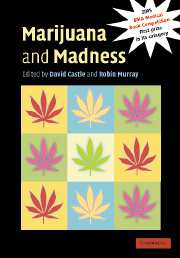Book contents
- Frontmatter
- Contents
- List of contributors
- Foreword
- Preface
- 1 The cannabinoid system: from the point of view of a chemist
- 2 How cannabis works in the brain
- 3 Acute and subacute psychomimetic effects of cannabis in humans
- 4 The association between cannabis use and depression: a review of the evidence
- 5 Cannabis and psychosis proneness
- 6 Is there a specific ‘cannabis psychosis’?
- 7 Cannabis as a potential causal factor in schizophrenia
- 8 Cannabis abuse and the course of schizophrenia
- 9 The endogenous cannabinoid system in schizophrenia
- 10 Cannabinoid ‘model’ psychosis, dopamine–cannabinoid interactions and implications for schizophrenia
- 11 Motives that maintain cannabis use among individuals with psychotic disorders
- 12 Addressing cannabis abuse in people with psychosis
- 13 Residual cognitive effects of long-term cannabis use
- Index
- References
1 - The cannabinoid system: from the point of view of a chemist
Published online by Cambridge University Press: 07 December 2009
- Frontmatter
- Contents
- List of contributors
- Foreword
- Preface
- 1 The cannabinoid system: from the point of view of a chemist
- 2 How cannabis works in the brain
- 3 Acute and subacute psychomimetic effects of cannabis in humans
- 4 The association between cannabis use and depression: a review of the evidence
- 5 Cannabis and psychosis proneness
- 6 Is there a specific ‘cannabis psychosis’?
- 7 Cannabis as a potential causal factor in schizophrenia
- 8 Cannabis abuse and the course of schizophrenia
- 9 The endogenous cannabinoid system in schizophrenia
- 10 Cannabinoid ‘model’ psychosis, dopamine–cannabinoid interactions and implications for schizophrenia
- 11 Motives that maintain cannabis use among individuals with psychotic disorders
- 12 Addressing cannabis abuse in people with psychosis
- 13 Residual cognitive effects of long-term cannabis use
- Index
- References
Summary
This book is about cannabis (marijuana) and psychotic illnesses; more specifically, it outlines how our increasing understanding of cannabis itself, the effects of cannabis on the brain and psychic functions and of the cannabinoid system can inform our understanding of the relationships between cannabis and psychosis. This chapter serves as an introduction to this topic, with a brief historical overview of the psychic effects of cannabis, followed by an exposition on the cannabinoid system.
Cannabis and mental illness
J. J. Moreau, the first nineteenth-century psychiatrist with an interest in psychopharmacology, described in great detail his experiments with hashish (Moreau, 1973). He took the drug himself and asked his students to follow his example. He also administered it to his patients. By modern standards the doses used were enormously high. The effects on one of his assistants, who swallowed 16 g of an extract – presumably containing several hundred milligrams of tetrahydrocannabinol (THC), which we know today to be the major psychotropic principal of cannabis – were intense agitation, incoherence, delirium and hallucinations. On the basis of numerous such experiments, Moreau declared that ‘there is not a single, elementary manifestation of mental illness that cannot be found in the mental changes caused by hashish, from simple manic excitement to frenzied delirium, from the feeblest impulse, the simplest fixation, the merest injury to the senses, to the most irresistible drive, the wildest delirium, the most varied disorders of feelings’.
- Type
- Chapter
- Information
- Marijuana and MadnessPsychiatry and Neurobiology, pp. 1 - 18Publisher: Cambridge University PressPrint publication year: 2004
References
- 1
- Cited by



